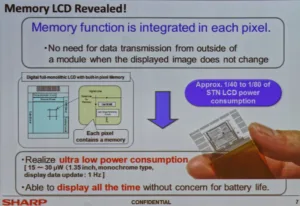 Jeremy Lock is from Sharp’s R&D lab in Oxford and he looks at all sizes of displays, but at the conference he talked about small displays for wearables.
Jeremy Lock is from Sharp’s R&D lab in Oxford and he looks at all sizes of displays, but at the conference he talked about small displays for wearables.
There are a lot of questions about wearables. Sharp has analysed some of the applications and has already found a big difference in the display requirements between sport watches and smart watches.
Sport watches need to be low power and readable outdoors, but smartwatches need to be good looking. Resolutions in mobile devices have changed a lot in recent years and there is a demand for high resolution, but power consumption in all smart devices is a challenge.
Memory LCD is something that Lock is involved in. It reduces power, but also looks good when used outdoors as it is reflective. Lock said that he also works on transflective and transmissive displays.
Memory LCD is unique in that there is a multi-transistor memory cell in each pixel. To further reduce power, you need to reduce the backlight power and so Sharp decided to use reflective technology in Memory LCD.
Sharp has CGS technology (which is Sharp’s version of LTPS – Man. Ed.) which is better than regular LTPS, Lock said, and much better than amorphous. The CGS has enough quality to include the LCD drivers in the design of the display.
Lock then showed data on typical memory LCDs, a 0.99″ display is a 10 microwatt display when there is just a static display and around 45 microwatt with 1Hz updating. A 2.7″ uses 50 microW or 175 microwatts with a 1Hz refresh. That may be 1000th of the power consumption of a TFT active display. Colour, of course, is just 1 bit, although he had an 8 colour demo.
There is a simple three wire serial port, a power port and a way of changing the display to respect the tendency to stick within the LC material. The structure of the display is very simple.
The Memory LCD is available for use and sale now.

